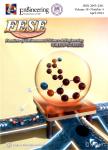Biosorption of Cu(II) to extracellular polymeric substances (EPS) from Synechoeystis sp.: a fluorescence quenching study
Biosorption of Cu(II) to extracellular polymeric substances (EPS) from Synechoeystis sp.: a fluorescence quenching study作者机构:State Key Laboratory of Desert and Oasis EcologyXinjiang Institute of Ecology and GeographyChinese Academy of SciencesUrumqi 830011China State Key Laboratory of Environmental GeochemistryInstitute of GeochemistryChinese Academy of SciencesGuiyang 550002China
出 版 物:《Frontiers of Environmental Science & Engineering》 (环境科学与工程前沿(英文))
年 卷 期:2012年第6卷第4期
页 面:493-497页
核心收录:
学科分类:081704[工学-应用化学] 07[理学] 08[工学] 0817[工学-化学工程与技术] 070302[理学-分析化学] 0703[理学-化学] 0713[理学-生态学]
主 题:biosorption conditional binding constant extracellular polymeric substances (EPS) fluorescence quenching
摘 要:Biosorption of extracellular polymeric substances (EPS) from Synechocystis sp. (cyanobacterium) with Cu(II) was investigated using fluorescence spectroscopy. Three fluorescence peaks were found in the excitation-emission matrix (EEM) fluorescence spectra of EPS. Fluorescence of peak A (Ex/Em = 275/452 nm) and peak C (Ex/Em= 350/452nm) were originated from humic-like substances and fluorescence of peak B (Ex/ Em= 275/338nm) was attributed to protein-like sub- stances. Fluorescence of peaks A, B, and C could be quenched by Cu(II). The effective quenching constants (lg Ka) were 2.8-5.84 for peak A, 6.4-9.24 for peak B, and 3.48-6.68 for peak C, respectively. The values of lg Ka showed a decreasing trend with increasing temperature, indicating that the quenching processes were static in nature. The binding constants (lg Kb) followed the order of peak A 〉 peak B 〉 peak C, implying that the humic-like substances in EPS have greater Cu(II) binding capacity than the protein-like substances. The binding site number, n, in EPS-Cu(II) complexes for peaks A, B, and C was less than 1. This suggests the negative cooperativity between multiple binding sites and the presence of more than one Cu binding site.



